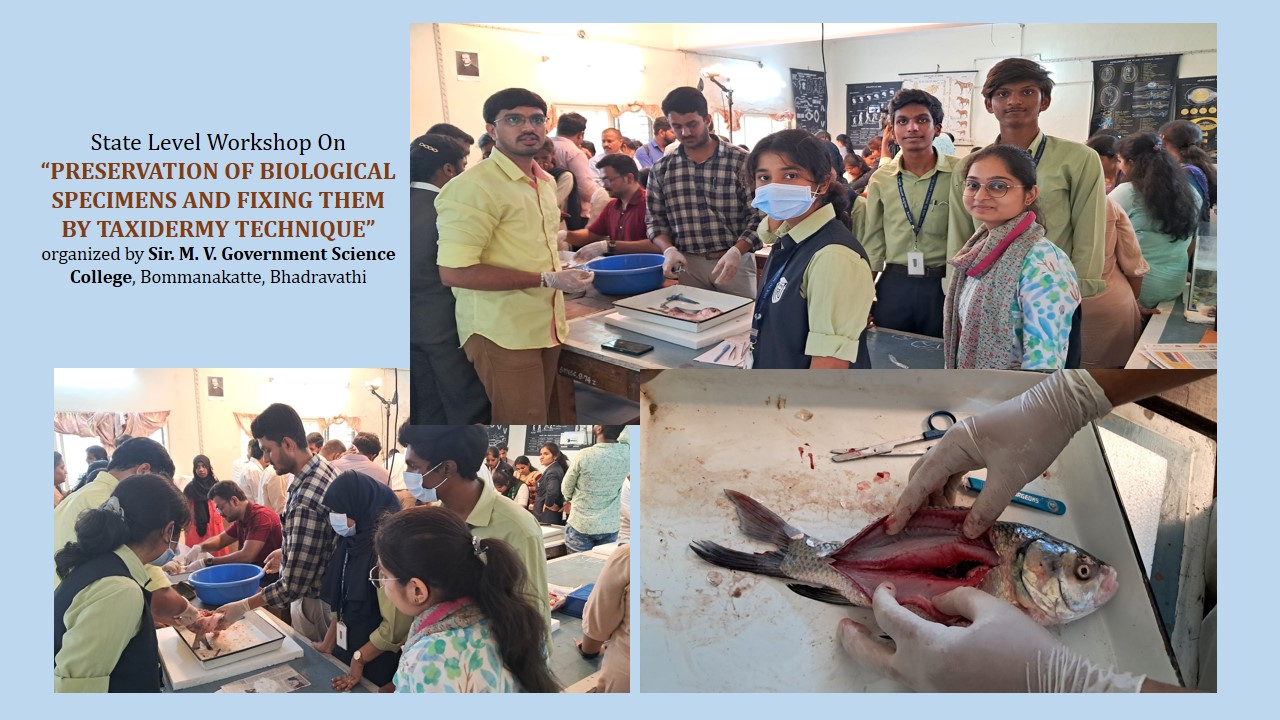
- Email info@kapmi.edu.in
- CONTACT 9448288483
- CONTACT 08182 200821


The one-day state-level workshop, organized by Sir. M. v. Government Science college, Bommanakatte, Bhadravathi, under the IQAC initiative, focused on the “Preservation of Biological Specimens and Fixing Them by Taxidermy Technique.” This workshop highlighted recent trends and the significance of preserving organisms for educational and scientific purposes, ensuring their availability for future generations.
The morning session began with an insightful presentation by Naveen Pyatimani, Assistant Professor and Taxidermist at Karnataka Science College, Dharwad. He explained the meaning of taxidermy, noting that it involves the preservation of dead animal skin for scientific purposes and for future generations to observe. He then went on to describe the purpose of preserving organisms, such as identifying the species, raising awareness and increasing public knowledge about these animals and their extinct forms in museums.
The presentation detailed various types of preservation methods, such as osteological preservation, where bones are preserved and studied for their structure and anatomy; Voucher specimens, which are representative organisms whose DNA is preserved; and composite specimens, where morphological, anatomical and functional parts are separated and preserved individually, among others.
Additionally, he showed us a list of materials used in preservation, including various basic and advanced tools and chemicals, such as sharp scalpels, bone cutters, galvanized wire, artificial eyes, Borax, naphthalene powder, potash alum and so on.
He also outlined the various uses of taxidermy which are,
He also spoke about various environmental and wildlife laws, with the “wildlife protection Act 1972” being highlighted for its importance in areas such as,
After the session, the participants were taken to the zoology laboratory to observe various zoological specimens. The lab contained a variety of organisms from each phylum, ranging from the smallest Porifera to the skeleton of a dolphin. The majority of these specimens had undergone wet preservation, including jellyfish, birds, and reptiles, while a few, such as snakes, had been taxidermied.
Practical Session –
The participants then proceeded to the area where the taxidermy setup was arranged for a hands-on experience. Under the guidance of Naveen Pyatimani, we were taught how to taxidermy a fish (Catla catla) in a stepwise manner. The steps were explained in detail using visual aids such as a projector and screen.
The major steps learned were:
In conclusion, both sessions led by Naveen Pyatimani were highly productive and informative, providing students with valuable insights into the field of taxidermy, its applications, and the importance of specimen preservation. The workshop successfully spread awareness about the significance of biological conservation and offered hands-on experience in taxidermy techniques.
We extend our heartfelt gratitude to Sir Naveen Pyatimani and the Sir. M. v. Government Science college, Bommanakatte, Bhadravathi, under the IQAC initiative for organizing such an insightful Workshop.
We also thank our College, Kateel Ashok Pai Memorial College, Principal Dr. Sandhya Kaveri, and the Department of Zoology, especially Deeksha Ma’am and Gowrishree Ma’am for their guidance and support in allowing us to be a part of this state level workshop.
Report By :
Michelle N R , Ayesha Suzain, Karthik Acharya, Akshaya G U
1st year BSc Students